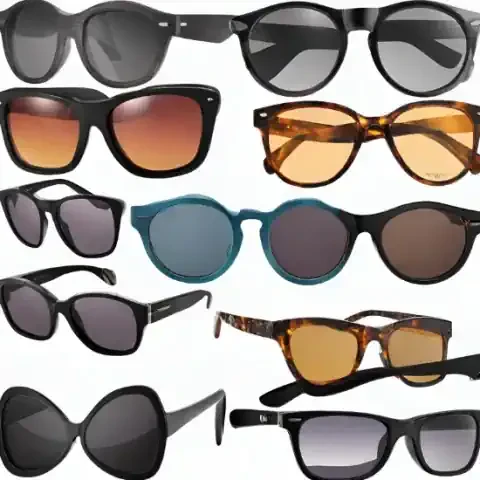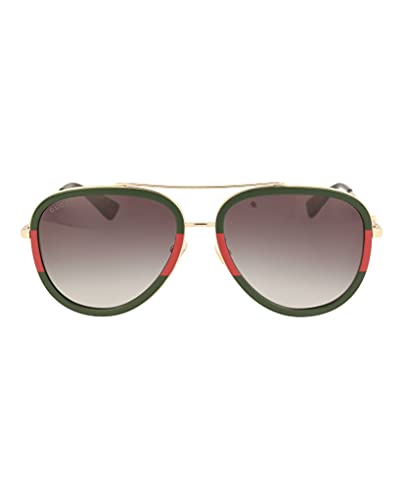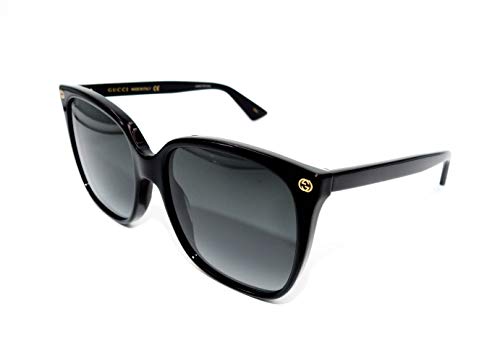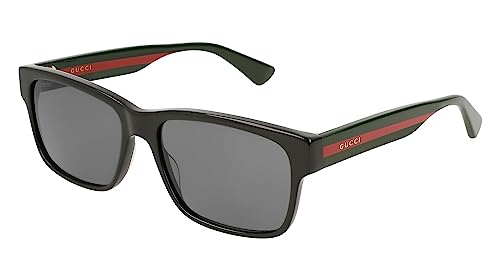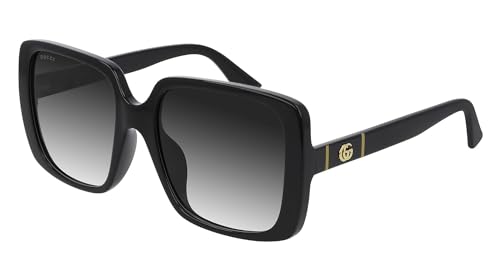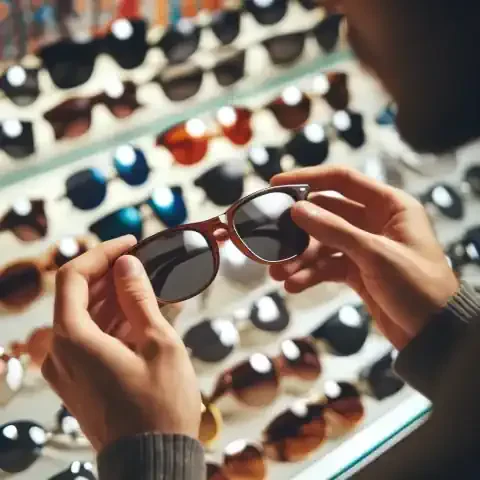Introduction
Sunglasses frames, though often overshadowed by their tinted lenses, serve as the structural backbone and stylistic anchor of every pair of sunglasses. As essential accessories in both fashion and function, sunglasses frames have evolved significantly over time, reflecting changes in cultural preferences, technological advancements, and fashion trends. This section will delve into the definition and purpose of sunglasses frames, their pivotal role in the realm of fashion and functionality, and an overview of the diverse array of frames available today.
Definition and Purpose of Sunglasses Frames
Sunglasses frames encompass the structural framework that holds the lenses in place, providing support and stability while also contributing to the overall aesthetic appeal of the eyewear. These frames can vary widely in design, material, and style, ranging from classic and understated to bold and avant-garde.
Beyond their aesthetic appeal, sunglasses frames serve several crucial purposes. Firstly, they offer protection and support to the lenses, ensuring they remain securely in place during wear and minimizing the risk of damage or breakage. Secondly, frames play a vital role in ensuring a comfortable fit, with considerations such as nose bridge design, temple length, and frame curvature all contributing to the overall wearing experience. Additionally, frames often incorporate hinges and adjustable features that allow for customization to suit individual preferences and facial contours.
Importance of Sunglasses Frames in Fashion and Functionality
In contemporary society, sunglasses have transcended their original function as mere eye protection to become indispensable fashion accessories. The frames, in particular, play a central role in shaping the overall aesthetic of the sunglasses and complementing the wearer's style and personality. Whether sleek and minimalist or bold and expressive, frames have the power to elevate an outfit, add a touch of sophistication, or make a bold fashion statement.
Moreover, sunglasses frames are not merely about style; they also serve crucial functional purposes. Beyond holding the lenses in place, frames provide structural integrity and durability, ensuring that the sunglasses can withstand daily wear and tear. Additionally, certain frame designs incorporate ergonomic features aimed at enhancing comfort and wearability, such as adjustable nose pads, lightweight materials, and flexible hinges.
Overview of Different Types of Sunglasses Frames
The world of sunglasses frames is incredibly diverse, offering a plethora of options to suit every taste, preference, and occasion. From timeless classics to contemporary innovations, there is a frame style to cater to every individual's unique sense of style and practical requirements. Some of the most iconic and popular sunglasses frame styles include the wayfarer, aviator, round, cat-eye, and oversized frames, each with its own distinct characteristics and allure.
In addition to these classic styles, there is a growing trend towards specialized frames tailored to specific activities or lifestyles, such as sport frames designed for athletic pursuits or wraparound frames for outdoor enthusiasts. Furthermore, advancements in technology and materials have led to the emergence of cutting-edge frame designs that incorporate smart features, lightweight alloys, and sustainable materials, paving the way for a new era of innovation in sunglasses design.
In summary, sunglasses frames are not merely functional accessories but also powerful symbols of style, identity, and self-expression. By understanding the importance of frames in both fashion and functionality, as well as the diverse array of styles and designs available, one can truly appreciate the significance of these understated yet essential components of every pair of sunglasses.
Historical Evolution of Sunglasses Frames
Sunglasses frames, like many fashion accessories, have a rich and fascinating history that reflects the evolving tastes, technologies, and cultural influences of different eras. This section will explore the origins of sunglasses frames, key innovations and transformations in frame designs over time, and the cultural and fashion influences that have shaped their development.
Origins of Sunglasses Frames
The concept of sunglasses dates back thousands of years, with early civilizations such as the Inuit and Chinese using rudimentary forms of eye protection made from materials like walrus ivory or smoky quartz to shield their eyes from the sun's glare. However, it wasn't until the Roman Empire that sunglasses as we know them began to take shape. Wealthy Romans would use emerald or quartz lenses held up to their eyes to reduce glare from the sun.
The first documented evidence of sunglasses with frames dates to the 12th century in China, where flat panels of smoky quartz were held over the eyes with frames made of bone or metal. These early sunglasses were primarily used by judges to conceal their facial expressions during court proceedings.
Key Innovations and Transformations in Frame Designs Over Time
The Renaissance saw advancements in lens crafting, leading to the development of spectacles with tinted lenses designed to protect against the sun's rays. However, it wasn't until the 18th century that sunglasses became widely popular among European aristocrats as a symbol of status and sophistication.
In the early 20th century, sunglasses underwent significant transformations with the introduction of mass production techniques and new materials such as celluloid and early plastics. This era saw the rise of iconic frame styles such as the round pince-nez and the double-bridge aviator frames, popularized by military pilots.
The mid-20th century marked a turning point in sunglasses fashion, with the introduction of the iconic Wayfarer frames by Ray-Ban in 1956. These bold, plastic frames represented a departure from traditional metal styles and became synonymous with rebellion and youth culture, thanks in part to their endorsement by celebrities such as James Dean and Audrey Hepburn.
Cultural and Fashion Influences on Sunglasses Frames
Throughout the 20th and 21st centuries, sunglasses frames have been heavily influenced by shifting cultural trends, technological advancements, and the evolving demands of fashion. From the sleek and futuristic designs of the 1960s to the oversized, glam-rock frames of the 1980s, each era has brought its own distinctive styles and silhouettes to the world of sunglasses.
Today, sunglasses frames continue to evolve in response to changing tastes and preferences, with designers drawing inspiration from a diverse range of sources, including art, architecture, nature, and technology. From avant-garde avant-garde designs to minimalist, understated frames, the possibilities are endless, reflecting the ever-changing landscape of fashion and self-expression.
In summary, the historical evolution of sunglasses frames is a testament to the ingenuity, creativity, and cultural significance of this essential fashion accessory. By tracing the origins of sunglasses frames and exploring their journey through history, we gain a deeper appreciation for the enduring appeal and timeless allure of these iconic pieces of eyewear.
Material Composition of Sunglasses Frames
Sunglasses frames are crafted from a variety of materials, each with its own unique properties, advantages, and aesthetic appeal. This section will delve into the common materials used in frame construction, the characteristics of each material, and the impact of material selection on durability, comfort, and style.
Common Materials Used in Frame Construction
Plastic: Plastic frames, often made from acetate or injected molded plastics, are lightweight, flexible, and available in a wide range of colors and finishes. Acetate, derived from plant-based cellulose, offers durability and can be polished to a high shine, making it a popular choice for designer eyewear. Injected molded plastics are more affordable and can be mass-produced in various shapes and styles.
Metal: Metal frames, typically crafted from materials such as stainless steel, titanium, or aluminum, offer durability, strength, and a sleek, sophisticated appearance. Stainless steel frames are corrosion-resistant and hypoallergenic, making them suitable for individuals with sensitive skin. Titanium frames are exceptionally lightweight and durable, making them ideal for those seeking comfort and longevity.
Acetate: Acetate frames, derived from plant-based cellulose, are known for their luxurious feel, vibrant colors, and distinctive patterns. Acetate frames can be handcrafted and polished to achieve a glossy finish, giving them a high-end aesthetic appeal. Additionally, acetate is highly durable and resistant to temperature fluctuations, making it an excellent choice for everyday wear.
Mixed Materials: Some sunglasses frames incorporate a combination of materials, such as metal accents on plastic frames or acetate temples on metal frames. These mixed-material frames offer the benefits of both materials, combining the strength and durability of metal with the versatility and aesthetic appeal of plastic or acetate.
Properties and Characteristics of Each Material
Plastic: Plastic frames are lightweight, affordable, and available in a wide range of colors and patterns. However, they may be less durable than metal frames and can warp or break under extreme heat or pressure.
Metal: Metal frames are durable, corrosion-resistant, and offer a sleek, sophisticated appearance. However, they may be heavier than plastic frames and can cause discomfort if not properly fitted.
Acetate: Acetate frames are luxurious, vibrant, and highly durable, with a smooth, polished finish. However, they may be more expensive than other materials and require special care to prevent scratching or damage.
Mixed Materials: Frames made from mixed materials offer the benefits of both metal and plastic, combining strength, durability, and aesthetic appeal. However, they may be more expensive than frames made from a single material and can vary in quality depending on the craftsmanship and design.
Impact of Material Selection on Durability, Comfort, and Style
The choice of material for sunglasses frames can significantly impact their durability, comfort, and style. Plastic frames are lightweight and versatile, making them ideal for casual wear or statement-making designs. Metal frames offer durability and strength, making them suitable for everyday wear or active lifestyles. Acetate frames exude luxury and sophistication, adding a touch of elegance to any ensemble.
In conclusion, the material composition of sunglasses frames plays a crucial role in determining their aesthetic appeal, durability, and comfort. By understanding the properties and characteristics of different materials, individuals can make informed choices when selecting sunglasses that suit their unique style preferences and lifestyle needs.
Types of Sunglasses Frames
Sunglasses frames come in a diverse array of styles, each with its own distinct characteristics, silhouette, and aesthetic appeal. This section will explore some of the most iconic and popular types of sunglasses frames, ranging from classic and timeless designs to contemporary and avant-garde styles.
Wayfarer Frames
Description: Wayfarer frames are characterized by their bold, angular shape, thick rims, and trapezoidal lenses. Originally introduced by Ray-Ban in 1956, wayfarers have become synonymous with retro style and timeless appeal.
Features: Wayfarer frames typically feature a keyhole bridge, distinctive temples, and a slightly oversized silhouette. They are available in a variety of colors and patterns, making them versatile and suitable for both casual and formal occasions.
Aviator Frames
Description: Aviator frames, also known as pilot frames, are characterized by their teardrop-shaped lenses, thin metal rims, and double or triple bridge design. Originally designed for military pilots in the 1930s, aviators have since become a staple of classic eyewear fashion.
Features: Aviator frames offer a sleek, minimalist aesthetic with a timeless appeal. They are available in a range of lens colors and materials, including classic dark lenses for sun protection and mirrored lenses for a modern twist.
Round Frames
Description: Round frames feature circular lenses and thin rims, evoking a retro-inspired aesthetic reminiscent of 1960s counterculture and bohemian style. Popularized by iconic figures such as John Lennon and Ozzy Osbourne, round frames have experienced a resurgence in popularity in recent years.
Features: Round frames come in various sizes, from small and subtle to large and oversized. They are often crafted from lightweight materials such as acetate or metal and are available in a range of colors and finishes to suit different style preferences.
Cat-Eye Frames
Description: Cat-eye frames are characterized by their upswept outer edges and distinctive winged silhouette, resembling the shape of a cat's eye. Originating in the 1950s, cat-eye frames are synonymous with retro glamour and feminine elegance.
Features: Cat-eye frames come in a variety of sizes and styles, from subtle and understated to bold and dramatic. They are often adorned with decorative embellishments such as rhinestones, pearls, or intricate patterns, adding a touch of vintage-inspired flair.
Oversized Frames
Description: Oversized frames feature large lenses and thick rims, creating a bold and statement-making look. Popularized in the 1970s and 1980s, oversized frames have remained a favorite among fashion-forward individuals seeking to make a bold style statement.
Features: Oversized frames offer ample coverage and sun protection, making them ideal for those seeking both style and functionality. They come in a variety of shapes, including square, rectangular, and oval, and are available in an array of colors and materials to suit different tastes and preferences.
In summary, the world of sunglasses frames is as diverse as it is stylish, with each type of frame offering its own unique charm and allure. Whether you prefer the classic appeal of wayfarer frames, the retro glamour of cat-eye frames, or the sleek sophistication of aviator frames, there is a frame style to suit every taste, personality, and occasion.
Frame Shape and Face Structure
The shape of sunglasses frames plays a crucial role in determining how well they complement the wearer's facial structure. Understanding how different frame shapes interact with various face shapes can help individuals choose sunglasses that enhance their features and achieve a balanced, flattering look. This section will explore the relationship between frame shape and face structure, providing insights and styling tips for selecting the perfect pair of sunglasses.
Matching Frame Shape to Face Shape
Round Face: Individuals with round faces typically have soft, curved features and a rounded chin. To add definition and balance to their facial structure, they should opt for sunglasses with angular frames such as square or rectangular shapes. These frames help create the illusion of sharper angles and add contrast to the softness of a round face.
Oval Face: Oval faces are considered the most versatile and balanced face shape, with gently rounded contours and balanced proportions. People with oval faces can experiment with a wide range of frame shapes, including aviators, wayfarers, and cat-eye frames, as their face shape is well-suited to most styles.
Square Face: Square faces are characterized by strong jawlines, broad foreheads, and angular features. Individuals with square faces should choose sunglasses with rounded or curved frames to soften their facial angles and add contrast to their sharp features. Round, oval, or cat-eye frames are excellent options for complementing square face shapes.
Heart Face: Heart-shaped faces are widest at the forehead and narrowest at the chin, resembling an inverted triangle. Sunglasses with bottom-heavy frames, such as aviators or cat-eye styles, help balance the proportions of a heart-shaped face by drawing attention downward and adding width to the lower half of the face.
Diamond Face: Diamond-shaped faces have narrow foreheads and chins, with prominent cheekbones as the widest part of the face. Sunglasses with oval or rounded frames help soften the angles of a diamond face shape and complement its natural contours. Frames that sit high on the nose bridge, such as aviators or semi-rimless styles, accentuate the cheekbones and draw attention to the eyes.
Considerations for Frame Size and Proportions
In addition to matching frame shape to face shape, it's essential to consider the size and proportions of sunglasses frames relative to the wearer's facial features. Oversized frames can overwhelm small faces, while petite frames may get lost on larger faces. Finding the right balance between frame size and facial proportions is key to achieving a harmonious and flattering look.
Styling Tips for Different Face Structures
Experiment with Different Styles: Don't be afraid to try on various frame shapes and styles to see what works best for your face shape. Keep an open mind and be willing to step outside your comfort zone to discover new looks that flatter your features.
Pay Attention to Fit: Ensure that the sunglasses sit comfortably on your face without pinching or sliding down your nose. The frames should rest snugly against your temples without leaving red marks or causing discomfort.
Consider Lens Size: In addition to frame shape, pay attention to the size and coverage of the lenses. Larger lenses offer more sun protection and coverage, while smaller lenses may be more lightweight and versatile for everyday wear.
By understanding how frame shape interacts with different face structures and considering factors such as size, proportions, and fit, individuals can select sunglasses that not only shield their eyes from the sun but also enhance their natural beauty and style. Whether you have a round, square, oval, heart, or diamond-shaped face, there are sunglasses frames out there that are perfectly suited to your unique features and personality.
Frame Features and Components
Sunglasses frames consist of various components and features that contribute to their functionality, comfort, and aesthetic appeal. Understanding these elements can help individuals make informed decisions when selecting sunglasses that meet their specific needs and preferences. This section will explore the key features and components found in sunglasses frames, including nose bridge designs, temple styles, hinge types, and decorative elements.
Nose Bridge Designs
Traditional Bridge: Traditional nose bridges consist of a single solid piece that rests across the nose. This design is simple and lightweight, making it suitable for a wide range of face shapes and sizes.
Keyhole Bridge: Keyhole bridges feature a distinctive cutout in the center, resembling the shape of a keyhole. This design helps distribute weight evenly across the nose and prevents the frames from sliding down, making it ideal for individuals with low nose bridges or those seeking added stability.
Adjustable Nose Pads: Some sunglasses frames feature adjustable nose pads that can be customized to fit the contours of the wearer's nose. These pads are often made from silicone or soft rubber and can be adjusted for height and width to ensure a comfortable and secure fit.
Temple Styles
Straight Temples: Straight temples extend straight back from the frame and curve slightly behind the ears. This classic temple style offers a secure fit and is suitable for a wide range of face shapes and sizes.
Curved Temples: Curved temples follow the natural curvature of the head, providing a snug and comfortable fit. This design helps prevent the frames from slipping down and is particularly well-suited to active individuals or those with larger heads.
Wraparound Temples: Wraparound temples curve around the sides of the head, offering added stability and coverage. This design is commonly found in sports sunglasses and provides a secure fit during high-intensity activities.
Hinge Types
Traditional Hinges: Traditional hinges consist of two interlocking metal pieces that allow the temples to fold inward when not in use. This hinge type is durable and reliable, making it suitable for everyday wear.
Spring Hinges: Spring hinges incorporate a small spring mechanism that allows the temples to flex outward slightly, providing a snug and comfortable fit. This hinge type is ideal for individuals with larger heads or those seeking added flexibility and comfort.
Frame Finishes and Decorative Elements
Patterns: Sunglasses frames may feature a variety of patterns, ranging from classic tortoiseshell and leopard print to geometric designs and floral motifs. These patterns add visual interest and personality to the frames, making them stand out from the crowd.
Colors: Frames are available in a wide range of colors, from classic black and brown to bold red, blue, and yellow. Colorful frames can add a pop of personality to any outfit and allow individuals to express their unique sense of style.
Embellishments: Some sunglasses frames are adorned with decorative embellishments such as studs, crystals, or metal accents. These embellishments add a touch of glamour and sophistication to the frames, elevating their aesthetic appeal and making them suitable for special occasions or evening wear.
By understanding the various features and components found in sunglasses frames, individuals can choose frames that not only complement their facial features but also provide the comfort, functionality, and style they desire. Whether you prefer a classic design with traditional hinges or a modern style with adjustable nose pads and wraparound temples, there is a pair of sunglasses frames out there that perfectly suits your needs and preferences.
Sunglasses Frame Maintenance and Care
Proper maintenance and care of sunglasses frames are essential to prolonging their lifespan, preserving their appearance, and ensuring optimal comfort and performance. This section will provide practical tips and guidelines for cleaning, storing, and maintaining sunglasses frames, as well as addressing common issues and troubleshooting techniques.
Cleaning and Storage Tips for Different Frame Materials
Plastic Frames: Use a mild soap or detergent and lukewarm water to clean plastic frames, avoiding harsh chemicals that may damage the material. Gently scrub the frames with a soft-bristled brush or cloth to remove dirt, oil, and debris. Rinse thoroughly and pat dry with a clean, lint-free cloth. Store plastic frames in a protective case when not in use to prevent scratching and damage.
Metal Frames: Metal frames can be cleaned using a solution of mild soap and warm water, followed by gentle scrubbing with a soft cloth or brush. Avoid using abrasive materials or harsh chemicals that may scratch or tarnish the metal. Dry the frames thoroughly with a clean, lint-free cloth and store them in a soft pouch or case to prevent scratches and dents.
Acetate Frames: Acetate frames require special care to maintain their luster and appearance. Clean acetate frames with a solution of mild soap and warm water, using a soft cloth or brush to remove dirt and debris. Avoid exposing acetate frames to extreme temperatures or prolonged sunlight, as this can cause warping or discoloration. Store acetate frames in a protective case away from direct sunlight and heat sources.
Preventative Maintenance to Extend Lifespan
Regular Inspection: Periodically inspect sunglasses frames for signs of damage, including loose screws, worn hinges, or warped frames. Tighten any loose screws using a small screwdriver and replace damaged or missing parts as needed.
Avoiding Extreme Conditions: Avoid exposing sunglasses frames to extreme temperatures, humidity, or direct sunlight, as these conditions can cause warping, discoloration, or damage to the materials. Store sunglasses in a cool, dry place when not in use and avoid leaving them in hot cars or near heating vents.
Proper Handling: Handle sunglasses frames with care to avoid bending, twisting, or dropping them, which can cause misalignment or damage to the frames. When removing sunglasses, use both hands to gently slide them off your face and avoid resting them on top of your head, as this can stretch out the frames.
Repairing Common Frame Issues
Loose Screws: If the screws in your sunglasses frames become loose, tighten them using a small screwdriver. Be careful not to overtighten the screws, as this can strip the threads or damage the frame.
Broken Temples: If a temple or hinge on your sunglasses frames breaks or becomes damaged, take them to a professional eyewear repair technician for repair or replacement. Attempting to fix broken temples yourself can cause further damage or compromise the integrity of the frames.
Scratched Lenses: If the lenses in your sunglasses frames become scratched or damaged, consider replacing them with new lenses or investing in a scratch-resistant coating to protect them from future damage.
By following these maintenance and care tips, individuals can ensure that their sunglasses frames remain in optimal condition and continue to provide comfort, style, and sun protection for years to come. Regular cleaning, proper storage, and preventative maintenance are key to preserving the appearance and performance of sunglasses frames, allowing them to withstand the rigors of daily wear and maintain their value and functionality over time.
Technological Advancements in Sunglasses Frames
The world of sunglasses frames has witnessed significant advancements in technology, leading to the development of innovative features and materials that enhance comfort, performance, and style. This section will explore the impact of technology on frame design and manufacturing, the incorporation of advanced materials and engineering techniques, and the integration of smart features that elevate the functionality of sunglasses frames.
Impact of Technology on Frame Design and Manufacturing
3D Printing: Advancements in 3D printing technology have revolutionized the process of frame manufacturing, allowing for greater precision, customization, and design flexibility. 3D-printed frames can be tailored to individual specifications, resulting in a perfect fit and enhanced comfort for the wearer.
Computer-Aided Design (CAD): CAD software enables designers to create intricate and complex frame designs with precision and accuracy. By utilizing CAD technology, designers can experiment with different shapes, dimensions, and materials to achieve optimal performance and aesthetics.
Advanced Manufacturing Techniques: Cutting-edge manufacturing techniques, such as laser cutting and CNC machining, allow for the production of frames with intricate details and seamless construction. These techniques enable designers to push the boundaries of creativity and innovation, resulting in frames that are both functional and visually stunning.
Incorporation of Advanced Materials and Engineering Techniques
Carbon Fiber: Carbon fiber frames are lightweight, durable, and exceptionally strong, making them ideal for sports and outdoor activities. The unique properties of carbon fiber allow for the creation of frames that are both lightweight and impact-resistant, providing superior protection and comfort for the wearer.
Titanium Alloys: Titanium alloys are prized for their strength, corrosion resistance, and hypoallergenic properties, making them an ideal choice for high-quality sunglasses frames. Titanium frames are lightweight yet durable, offering unparalleled comfort and longevity.
Memory Metals: Memory metals, such as nitinol, possess the ability to return to their original shape after being bent or deformed, making them ideal for flexible and resilient frame designs. Frames made from memory metals offer a customized fit and superior durability, adapting to the wearer's face for maximum comfort.
Integration of Smart Features
Augmented Reality (AR) Lenses: Some sunglasses frames are equipped with AR lenses that provide real-time information and augmented reality overlays, enhancing the wearer's visual experience. AR-enabled sunglasses can display navigation directions, fitness metrics, and other relevant information directly within the wearer's field of view.
UV Sensors: Sunglasses frames with built-in UV sensors can monitor UV exposure levels and provide alerts when the wearer is at risk of overexposure. These sensors help individuals track their sun exposure and take proactive measures to protect their eyes from harmful UV radiation.
Bluetooth Connectivity: Bluetooth-enabled sunglasses frames allow users to wirelessly connect to their smartphones or other devices, enabling hands-free calling, music streaming, and voice commands. Bluetooth sunglasses offer convenience and connectivity without the need for additional accessories or devices.
In summary, technological advancements have transformed the landscape of sunglasses frames, paving the way for innovative designs, materials, and features that enhance comfort, performance, and functionality. From 3D-printed frames to carbon fiber construction and smart features like AR lenses and UV sensors, modern sunglasses frames offer a blend of style, technology, and utility that meets the demands of today's discerning consumers.
Sustainable Practices in Sunglasses Frame Production
In recent years, there has been a growing emphasis on sustainability within the eyewear industry, with an increasing number of brands adopting eco-friendly practices and materials in the production of sunglasses frames. This section will explore the environmental impact of sunglasses manufacturing, the adoption of sustainable materials and production processes, and initiatives aimed at promoting sustainability and reducing the industry's carbon footprint.
Environmental Impact of Sunglasses Manufacturing
Resource Consumption: The production of sunglasses frames often involves the extraction of raw materials such as plastic, metal, and acetate, which can deplete natural resources and contribute to habitat destruction and biodiversity loss.
Energy Consumption: The manufacturing process requires significant energy inputs, including electricity and fossil fuels, leading to greenhouse gas emissions and air pollution. Additionally, transportation and logistics further contribute to the carbon footprint of sunglasses production.
Waste Generation: Sunglasses manufacturing generates waste at various stages of the production process, including excess materials, packaging, and byproducts. Improper disposal of waste can lead to environmental contamination and ecosystem degradation.
Adoption of Eco-Friendly Materials and Production Processes
Recycled Materials: Many eyewear brands are incorporating recycled materials, such as recycled plastic and metal, into their sunglasses frames. By diverting waste from landfills and reducing the demand for virgin materials, recycled frames help conserve natural resources and minimize environmental impact.
Biodegradable Materials: Some brands are exploring the use of biodegradable materials, such as plant-based plastics and bio-acetate, in sunglasses frame production. These materials decompose naturally over time, reducing the environmental burden of plastic pollution and landfill waste.
Sustainable Sourcing: Eyewear companies are increasingly prioritizing sustainable sourcing practices, such as responsibly managed forests and ethical labor standards, to ensure the integrity and traceability of their supply chains. By sourcing materials from certified suppliers and supporting fair labor practices, brands can promote social and environmental sustainability.
Recycling and Upcycling Initiatives
Take-Back Programs: Some eyewear brands offer take-back programs that allow customers to return old or unwanted sunglasses frames for recycling or repurposing. These programs help reduce waste and encourage responsible disposal of eyewear products at the end of their lifecycle.
Upcycled Materials: Upcycling involves repurposing waste materials, such as plastic bottles or discarded eyewear, to create new products or components. By incorporating upcycled materials into sunglasses frames, brands can reduce the demand for virgin resources and promote circular economy principles.
Closed-Loop Systems: Closed-loop systems aim to minimize waste and maximize resource efficiency by recycling and reusing materials throughout the production process. By implementing closed-loop systems, eyewear companies can reduce their environmental footprint and contribute to a more sustainable future.
In conclusion, the adoption of sustainable practices in sunglasses frame production is essential for mitigating the environmental impact of the eyewear industry and promoting a more sustainable future. Through the use of eco-friendly materials, responsible sourcing, and recycling initiatives, eyewear brands can minimize resource consumption, reduce waste generation, and contribute to the preservation of the planet's ecosystems for future generations.
Future Trends and Innovations in Sunglasses Frames
The future of sunglasses frames is poised for exciting developments, driven by advancements in technology, changing consumer preferences, and a growing emphasis on sustainability. This section will explore emerging trends and innovations in sunglasses frame design, materials, and functionality, offering insights into the direction of the industry in the coming years.
Predictions for Emerging Frame Styles and Designs
Minimalist Designs: Future sunglasses frames are likely to feature sleek, minimalist designs with clean lines and understated aesthetics. Minimalist frames offer versatility and timeless appeal, appealing to consumers seeking a modern yet classic look.
Customization Options: Personalization and customization will play a significant role in the future of sunglasses frames, with brands offering a range of options for consumers to tailor their frames to their individual preferences. Customizable features may include interchangeable temples, adjustable nose pads, and personalized engraving.
Innovative Shapes and Materials: Expect to see sunglasses frames in unconventional shapes and materials, pushing the boundaries of traditional design and aesthetics. From geometric silhouettes to avant-garde materials such as graphene or bio-based composites, designers will explore new possibilities for frame construction and innovation.
Influence of Fashion, Technology, and Sustainability
Fashion-forward Technology Integration: Sunglasses frames will increasingly incorporate smart features and technology-driven innovations, blurring the lines between fashion accessories and wearable tech. From augmented reality displays to biometric sensors, smart sunglasses will offer enhanced functionality and connectivity for the tech-savvy consumer.
Sustainable Solutions: Sustainability will continue to be a driving force in the future of sunglasses frame design, with brands prioritizing eco-friendly materials, ethical sourcing practices, and circular economy principles. From biodegradable frames to closed-loop production systems, the industry will strive to reduce its environmental impact and promote sustainable consumption.
Collaborations and Cross-industry Partnerships: Expect to see more collaborations and partnerships between eyewear brands and other industries, such as fashion, technology, and healthcare. These collaborations will drive innovation and creativity, resulting in groundbreaking designs and novel solutions that cater to diverse consumer needs and preferences.
Shifts in Consumer Preferences and Industry Direction
Focus on Health and Wellness: With an increasing emphasis on health and wellness, sunglasses frames will incorporate features and technologies that prioritize eye protection, comfort, and UV protection. Anti-blue light coatings, adjustable fit options, and ergonomic designs will cater to consumers seeking eyewear that supports their overall well-being.
Demand for Sustainable and Ethical Practices: Consumers will continue to demand transparency and accountability from eyewear brands, driving industry-wide efforts to adopt sustainable and ethical practices. Brands that prioritize environmental stewardship, social responsibility, and transparency in their supply chains will resonate with conscious consumers.
Globalization and Cultural Influences: Globalization will continue to shape the future of sunglasses frames, with trends and influences transcending geographical boundaries. Cultural diversity and inclusivity will inspire new design aesthetics and styles, reflecting the rich tapestry of global fashion and lifestyle trends.
In summary, the future of sunglasses frames is marked by innovation, sustainability, and consumer-centric design. From minimalist aesthetics to smart features and sustainable materials, the industry is poised for exciting developments that cater to the evolving needs and preferences of consumers worldwide. By embracing emerging trends and embracing a commitment to sustainability and innovation, eyewear brands can shape the future of sunglasses frames and redefine the boundaries of fashion, technology, and functionality.
Sunglasses Frames Summary
Sunglasses frames represent not only a functional necessity but also a fashion statement, reflecting personal style and complementing facial features. This comprehensive exploration of sunglasses frames delved into various aspects, starting with the historical evolution, which showcased how sunglasses frames have transitioned from rudimentary eye protection to iconic fashion accessories throughout the ages.
The discussion then moved to the material composition of frames, highlighting the characteristics of plastic, metal, acetate, and mixed materials, and their impact on durability, comfort, and style. Understanding the relationship between frame shape and face structure was emphasized in Section III, where matching frame shapes to different face shapes was elucidated to help individuals choose frames that enhance their natural features.
Moreover, the section on frame maintenance and care underscored the importance of proper cleaning, storage, and repair techniques in prolonging the lifespan of sunglasses frames, ensuring they remain in optimal condition for years to come.
Technological advancements in frame production were examined in depth, showcasing how innovations such as 3D printing, advanced materials, and smart features are reshaping the future of sunglasses frames, paving the way for enhanced functionality, sustainability, and customization.
Speaking of sustainability, the article outlined the increasing adoption of eco-friendly practices and materials in sunglasses frame production, as well as initiatives aimed at reducing the industry's environmental footprint and promoting responsible consumption.
Finally, the discussion on future trends and innovations offered insights into emerging styles, materials, and technologies that are expected to shape the direction of the industry in the years to come, highlighting the intersection of fashion, technology, and sustainability in driving forward the evolution of sunglasses frames.
Overall, this exploration of sunglasses frames provides a comprehensive overview of the history, design, maintenance, and future outlook of this essential fashion accessory, underscoring its enduring relevance and significance in both fashion and function.
